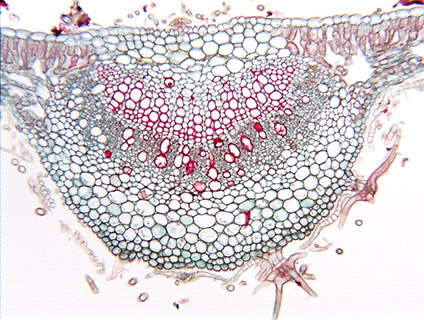 Fig.
10.4-6.
Transverse section of leaf midrib oleaster (Elaeagnus). This leaf has highly branched trichomes, but the
microtome knife has cut many of them off of each trichome. For complex trichomes
like this, a simple hand lens is usually good enough to give you an excellent
view of the leaf surface. You can usually buy a hand lens at a campus bookstore
for less than $20 and then examine a remarkable amount of plant surface Ė
donít think that you need a lot of expensive equipment to explore plant
anatomy.
Fig.
10.4-6.
Transverse section of leaf midrib oleaster (Elaeagnus). This leaf has highly branched trichomes, but the
microtome knife has cut many of them off of each trichome. For complex trichomes
like this, a simple hand lens is usually good enough to give you an excellent
view of the leaf surface. You can usually buy a hand lens at a campus bookstore
for less than $20 and then examine a remarkable amount of plant surface Ė
donít think that you need a lot of expensive equipment to explore plant
anatomy.